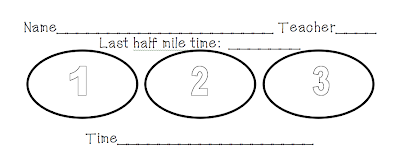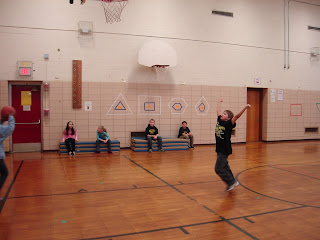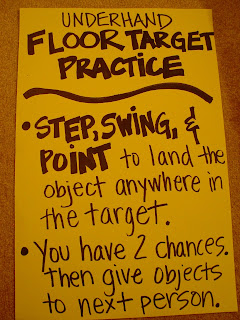I haven't updated the PE blog in 1 month! It's been a busy month -- planning the Heritage Festival took a lot of time and energy in the last two weeks of January, and now Jump Rope and Hoops for Heart have taken over -- along with a couple of
snow days,
Valentine's Day and preparing for mid-winter break!
Since January 15, here is what has been happening in PE classes:
Jump Rope and Jump Rope for Heart
Grades K-2 started jump rope skills. We have worked very hard on jumping rope basics. Start with the rope behind feet, swing it overhead and then try to jump over it with feet together. We use the keywords
Back, Front, Jump to make this sequence easier to remember. The most common corrections when students are first learning this skill include separating their feet and swinging the rope over backward. Students often separate their feet and step/jump over the rope this way at first -- this results in more misses because it creates more body parts for the rope to catch on. Some students try to swing the rope backward - it is slightly easier for some to master swinging the rope this way first, but it's much harder to learn to rhythmically jump over backwards before learning to jump over the forward swinging rope.
To give students small group time with me, we divided into centers. Two centers were specifically about jumping rope, and the other two were fitness centers. I spent most of each class at one center, helping students at their individual level to improve their skills. Some were ready for some more advanced tricks, and others needed basic skills work. A free jump allowed students to work individually on their rope jumping. The other two centers reviewed overhand/underhand throwing, and balance activities.
Basketball Skills and Hoops for Heart
Grades 3-5 have started basketball skills. Basic skills include dribbling, passing, and shooting. With most basketball activities, I allow students to choose between a basketball and a playground ball. This allows students to self-select based on their comfort level with basketball skills.
This week, we participated in a basketball obstacle course. Students practice wall chest passes, dribbled to shoot on either the center hoop or side basketball hoop, and then dribbled back to the start. We did this continuously for about 10 minutes, so students had several turns to practice those skills in sequence. Then, students had a choice: basketball shooting or Lightning Recycle on one half of the gym or jump rope activities on the other half of the gym.
Jump Rope and Hoops For Heart
Jump Rope and Hoops for Heart are fundraising programs for the American Heart Association All students participate in the program, regardless of donations. We learn jump rope and/or basketball skills, and we talk about how some people have special hearts - hearts that need medicine and/or surgery to keep working. The American Heart Association funds research to find medicines, surgery and education to keep hearts healthy. We do this program annually, and it corresponds with our physical education and health topics each year. This year, donations are due Friday, February 15 in the main office. Thank you for your support!
Student Assistant for 1/2 Day
 |
| My student assistant making sure centers were going smoothly. |
One lucky student won the silent auction item to be the PE teacher assistant for half day! She assisted me with lower elementary classes on Tuesday, February 12. This lucky student had her very own whistle, and it even matched her outfit! The activity for each class was centers, so she helped me explain the directions to each class. She helped make sure everyone was following the rules, and then she used her whistle and the microphone to let groups know it was time to "clean up, sit, and point" to the next center. Thank you, M, for your help that day! :):) I am so glad you got to help me for the afternoon!








.jpg)
.jpg)






































